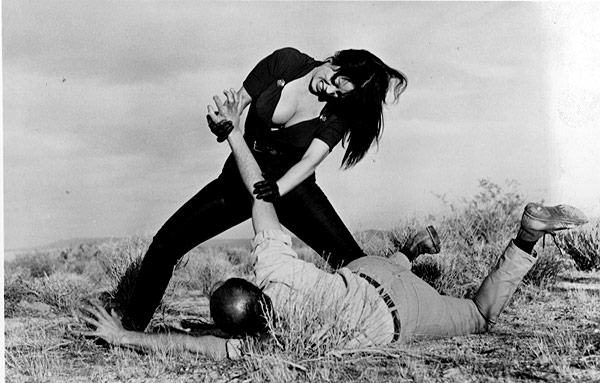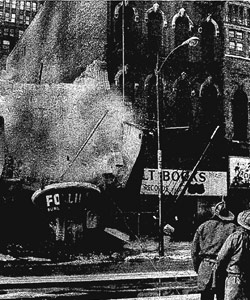
Tura Satana stars in Russ Meyer’s Faster, Pussycat! Kill! Kill!
We knew her best as Tura Satana, the outrageously buxom movie star who died last week in Reno, Nevada. But long before she won pop-cult enshrinement as the badass girl-gang leader Varla in Russ Meyer’s 1965 movie Faster, Pussycat! Kill! Kill!, she had achieved another sort of notoriety on Chicago’s burlesque stages, where she performed as Miss Japan Beautiful.
But Satana’s overlooked contribution to the finer arts may be the lessons in shaking and lovemaking she claims to have given Elvis Presley after an encounter in a State Street strip club circa 1955. It all makes for a great story—if only it were true.
Satana was born Tura Luna Pascual Yamaguchi in Japan on July 10, 1938 (though her obituary in the New York Times noted that other sources gave her birth year as 1935). Her family eventually immigrated to the United States and spent part of World War II interned at the Manzanar War Relocation Center near Lone Pine, California. After the war they either moved or were relocated to Chicago, though the exact date is uncertain. Her memories of selling newspapers outside the Rialto Theatre, at 336 South State Street, when she was seven years old seem chronologically improbable, though clearly the club—part of the Minsky’s burlesque circuit—and its performers and clientele left an indelible impression on the girl.
With her family, young Tura lived in the Jane Addams Homes—near Taylor Street and Racine Avenue—and she attended the Jacob A. Riis Elementary School on South Lytle Street. (Her childhood home and school have both been demolished.) It was not a happy time. Tormented because of her Asian appearance and heritage—“I was constantly taunted about being a Tojo, a monkey-person,” she wrote in her unpublished autobiography—she also drew unwanted attention for her precociously voluptuous figure, which she tried to hide with baggy clothing. It didn’t work. According to Satana, shortly before her tenth birthday, while returning home from a local bakery, she was grabbed by five men, who threw her into a car and raped her.
Further indignities awaited her. As Satana told the story (in Big Bosoms and Square Jaws—Jimmy Meyer’s 2005 biography of Russ Meyer—and Pamela Des Barres’s 2008 Let’s Spend the Night Together: Backstage Secrets of Rock Muses and Supergroupies), the cop who came to her aid turned out to be the cousin of one of her assailants. A payoff to a Chicago judge—“One thousand dollars for a little girl’s virginity,” is how she put it years later—kept the case from going to trial. In fact, Satana said, she was the one sent to reform school “for tempting those boys into raping me. I was classified a juvenile delinquent.”
Once she returned home, Satana’s father taught her various martial arts—she would go on to earn a green belt in aikido and a black belt in karate—and she took command of a vengeful gang of girls. “We patrolled the neighborhood to keep that kind of thing from happening to anybody else,” she told Des Barres. She also claimed to have tracked down each of her assailants, though it took 15 years. “I made a vow to myself that I would someday, somehow get even with all of them,” she said in Big Bosoms. “They never knew who I was until I told them.”
By some accounts, Satana briefly attended McKinley High School—situated near Adams Street and Damen Avenue, the building is currently home to the NIA/Foundations Middle School—before, at the age of 13, she fled Chicago and a short-lived arranged marriage for Los Angeles. Working as a swimsuit model, she was noticed by the silent-film star Harold Lloyd, who encouraged her to get into movies. By 1954 she was back in Chicago, where she began her career as an exotic dancer. She first appeared nude in an act called “Galatea, the Statue That Came to Life” at, as she later described it, the “sleazy” Rendezvous Club in Calumet City.
“The people who came to Calumet City were mostly people who worked in the factories and stuff around there,” Satana told the Chicago Tribune’s Robert K. Elder in 2008. “It was mostly blue-collar workers and roughnecks. When you got too old to dance there, then they moved you down the road to a row of houses for extracurricular activities. I didn’t stick around for that. I wore a Japanese kimono. . . . I wore a huge headdress, and I carried my own Buddha. He would sit on a stool on the stage. After the dance routine, I’d take a very small hara-kiri knife and [pretend to] kill myself.”
After a couple of years, Satana moved on to Chicago’s downtown burlesque houses, where she billed herself as Miss Japan Beautiful—though not everybody got the joke. “Randolph Street’s Brass Rail outdid itself, bringing in five Japanese striptease stars, including Tura Satana, Miss Japan of 1959, and they’re wow,” the Trib’s Herb Lyon wrote in a September 1960 “Tower Ticker” column.
 Satana’s pivotal—or is it apocryphal?—encounter with Elvis Presley allegedly occurred backstage at the Follies Theater at 450 South State Street (the club burned down in January 1978; the Harold Washington Library Center now occupies the site). According to Satana, the two of them had first met in Biloxi, Mississippi. Presley had yet to achieve any sort of fame, but Miss Japan Beautiful, only 16, was already touring. A year later—by my reckoning, in 1955—Elvis, in town to perform at the Chicago Theatre (by Satana’s account), caught her act at the Follies Theater and came backstage to reintroduce himself.
Satana’s pivotal—or is it apocryphal?—encounter with Elvis Presley allegedly occurred backstage at the Follies Theater at 450 South State Street (the club burned down in January 1978; the Harold Washington Library Center now occupies the site). According to Satana, the two of them had first met in Biloxi, Mississippi. Presley had yet to achieve any sort of fame, but Miss Japan Beautiful, only 16, was already touring. A year later—by my reckoning, in 1955—Elvis, in town to perform at the Chicago Theatre (by Satana’s account), caught her act at the Follies Theater and came backstage to reintroduce himself.
“When he wondered how she moved the way she did,” writes Des Barres, “Tura told him her routine was based on martial arts. . . . He wanted to know how she did the slide and the splits at the same time. How she did the shimmy, how she shook all over. He was quite intrigued.”
The lessons didn’t stop there. With Elvis hanging around in Chicago, the couple began to date, but Satana wasn’t thrilled with her new boyfriend’s “wet fish” kisses. Additional instructions were in order. “I didn’t do a French kiss at first,” she told Des Barres. “I wanted to show him the beginnings of it. Then when he felt my tongue going around his lips, he went ‘Mmmm,’ and he opened his mouth and I showed him how to French kiss. . . . Once I showed him the difference between how he was kissing and how I kissed, he said, ‘Oh God, that feels so good.’ When I said, ‘Yeah, it feels good all over too,’ his eyes lit up.”
Satana went on to describe a series of secret dates and a blossoming romance that included at least one meal together at her parents’ home—as well as more intimate tutorials in the bedroom. Smitten, Elvis finally popped the question. “He proposed to me, but I turned him down,” she told Dave Hoekstra of the Sun-Times in 2008, when she returned to Chicago for the first time in 33 years to attend the art exhibition Tura! Tura! Tura! at the Tattoo Factory Gallery. “I told him if anyone knew about us being engaged it would cost him his career. I tried to give him his ring back and he told me to keep it. He said, ‘You will always have part of me with you.’ And I still have it. It’s a solitaire diamond, about three carats.”
Unfortunately, Satana’s story doesn’t hold up under close scrutiny. In 1955, Elvis was little known outside of the South—he wouldn’t burst onto the national scene until early 1956 with the release of “Heartbreak Hotel”—and he certainly wasn’t yet the caliber of performer to earn a gig at the Chicago Theatre. In fact, it doesn’t appear that he performed in Chicago until March 27, 1957, when he sang and gyrated in a gold lamé suit before 12,000 screaming fans at the old International Amphitheater (at 4220 South Halsted Street until its demolition in 1999). What’s more, Satana doesn’t show up in any of the definitive Presley books, including Peter Guralnick’s two-volume biography—Last Train to Memphis and Careless Love—and Adam Victor’s 600-page Elvis Encyclopedia.
But the impact of Satana’s violent Chicago childhood is not to be denied. It would serve as the wellspring for her onscreen persona, most notably in her performance as Varla in Faster, Pussycat! Kill! Kill! “Basically Varla was a part of my character from when I lived in Chicago,” she told the Trib’s Elder. “It was hard, and it helped develop a lot of anger in me that I never realized I was holding inside until Russ [Meyer] and I got going on the part. . . . That basically is where Varla came from, some of the anger over what happened to me.”
Or as she put in her unpublished autobiography, The Kick-Ass Life of Tura Satana: “This is where Varla was created in me. She was born in Chicago.”


